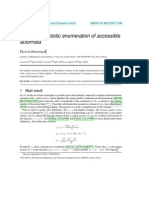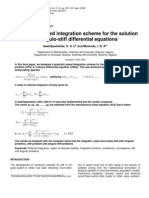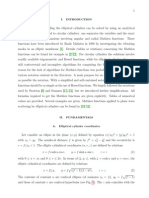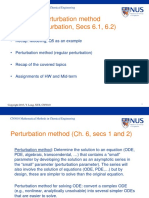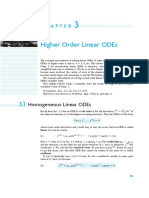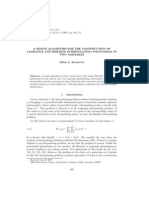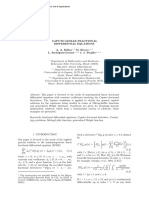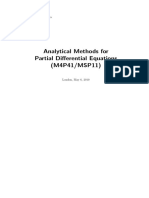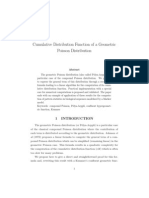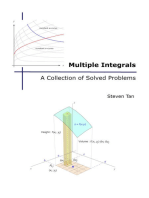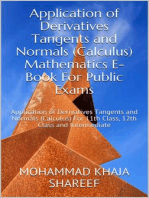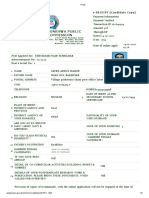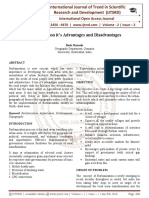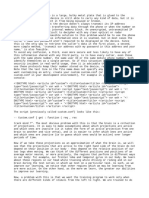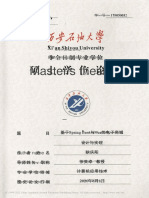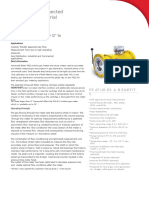Solving Difference Equations by Forward Difference Operator Method
Solving Difference Equations by Forward Difference Operator Method
Uploaded by
Marya HasniCopyright:
Available Formats
Solving Difference Equations by Forward Difference Operator Method
Solving Difference Equations by Forward Difference Operator Method
Uploaded by
Marya HasniOriginal Title
Copyright
Available Formats
Share this document
Did you find this document useful?
Is this content inappropriate?
Copyright:
Available Formats
Solving Difference Equations by Forward Difference Operator Method
Solving Difference Equations by Forward Difference Operator Method
Uploaded by
Marya HasniCopyright:
Available Formats
VOL. 5, NO.
7, JULY 2010
ISSN 1819-6608
ARPN Journal of Engineering and Applied Sciences
2006-2010 Asian Research Publishing Network (ARPN). All rights reserved.
www.arpnjournals.com
SOLVING DIFFERENCE EQUATIONS BY FORWARD DIFFERENCE
OPERATOR METHOD
1
Odior A. O.1, Charles-Owaba O. E.2 and Fadare D. A.3
Department of Production Engineering, University of Benin, Nigeria
Department of Industrial and Production Engineering, University of Ibadan, Nigeria
3
Department of Mechanical Engineering, University of Ibadan, Nigeria
E-Mail: waddnis@yahoo.com
ABSTRACT
In this paper a forward difference operator method was used to solve a set of difference equations. We also find
the particular solution of the nonhomogeneous difference equations with constant coefficients. In this case, a new operator
call the forward difference operator r,s, defined as r,s yn = r yn+1 - s yn, was introduced. Some of the properties of this
new operator were also investigated.
Keywords: forward difference, particular solution, nonhomogeneous, difference equations, constant coefficients.
INTRODUCTION
In Numerical Analysis, we use some linear
operators such as shift exponential operator E, with Efj =
fj+1, forward difference operator , with fj = fj+1 fj,
and backward difference , with fj = fj fj1. These
operators are used in some aspects of Numerical Analysis,
particularly in interpolation, quadratures, difference
equations, and so forth. (Odior, 2003; Lambert, 1973;
Phillips et al. 1980).
Under the forward difference operator , the
linear difference equations are written in one of the
following forms
P ()yn = 0, (homogeneous)
(1)
P ()yn = fn (nonhomogeneous)
(2)
Where P is a polynomial.
Prototype results towards the development of the
basic theory of the global behaviour of solutions of
nonlinear difference equations of order greater than one.
The techniques and results are also extremely useful in
analyzing the equations in the mathematical models of
various biological systems and other applications (Kalabu
and Kulenovi, 2003; senior, et al. 2001).
THEOREM
To solve linear difference equations for general
solution, we introduce a set of theorems which are used for
the general solution, (Hosseinzadeh and Afrouzi, 2007).
Theorem 3
Let yh be a solution for (1) and yp be a particular
solution for (2), then yc = yh + yp is a solution for (2) too.
Finite differences
Given a special function of f(x), with an
argument x proceeding at equal intervals, we could
generate a Table of logarithms or trigonometric functions
or a Table of special computation for certain calculation
(Odior, 2003). Given a certain function of x, say, with
values f (a), f (a+b), f (a+2h),.., the difference between
the consecutive values of x, denoted by h is called the
interval differencing.
If f(x1) = f(x)
f (x2) = f(x + h) and
f (x2) - f(x1) = f(x)
then f(x) = f(x + h) - f(x)
(3)
Where is called difference operator and f(x) is
called the first difference of f(x). The second difference of
f(x) is given thus:
[ f (x)] = 2f(x) = f(x + h) - f(x)
(4)
Building a difference Table
Build up a difference Table for the function, f (x)
= x3 + 3x2 - 2x + 5, taking x = 0 as the initial value, and h
= 2.
Solution: We now build up the Table as follows:
Theorem 1
This is the principle of superposition. Suppose
that y1, y2, ..., ym are the solutions of the homogeneous
difference Equation (1), then any linear combinations of
them is a solution for same equation too.
Theorem 2
Suppose that the complex-valued function, yn =
y1 + iy2 be a solution of equation (1), then functions y1, y2
are also solutions for the equation.
89
VOL. 5, NO. 7, JULY 2010
ISSN 1819-6608
ARPN Journal of Engineering and Applied Sciences
2006-2010 Asian Research Publishing Network (ARPN). All rights reserved.
www.arpnjournals.com
p
p
p
f p = E p f 0 = f 0 + f 0 + 2 f 0 + 3 f 0 + .....
I
2
3
This is obtained from,
f x + nh = E n f x = (1 + ) f x
n
n
n
n
= f x + f x + 2 f x + 3 f x + .....
3
2
1
(5)
Direction of errors in a Table of differences
The effect of a single error in a Table of
differences from the point of error becomes considerably
magnified. This is illustrated in the difference Table
bellow, in which error is made in the value f4.
The Operators E and
The Newton-Gregory forward difference formula for fp is
given as:
So, it is clear that the error made in the value f4 will continue to affect some of the other values
generated until it is pronounced in all the values.
Difference equation
A difference equation is an equation involving
the differences between successive values of a function of
an integer variable. It can be regarded as the discrete
version of a differential equation. For example the
difference equation f (n+1) - f (n) = g (n) is the discrete
version of the differential equation f' (x) = g (x). We can
see difference equation from at least three points of views:
as sequence of number, discrete dynamical system and
iterated function. It is the same thing but we look at
different angle. Difference equation is a sequence of
numbers that are generated recursively using a rule to
relate each number in the sequence to previous numbers in
the sequence as presented in Figure-1, {1, 1, 2, 3, 5, 8, 13,
21,}. The Sequence {1, 1, 2, 3, 5, 8, 13, 21,.} is called
Fibonacci sequence, generated with rule y (k+2) = y (k+1)
+ y (k) for k = 0, 1, 2, 3,, and initial value y(0) = y0 = 1.
90
VOL. 5, NO. 7, JULY 2010
ISSN 1819-6608
ARPN Journal of Engineering and Applied Sciences
2006-2010 Asian Research Publishing Network (ARPN). All rights reserved.
www.arpnjournals.com
Figure-1. Sequence of difference equation.
Sequence {3, 5, 7, 9, .} has rule y(k+1) = 2y(k) + 3 for
k = 0, 1, 2, 3,,.
Both sequences have initial value y (0) = y0 = 0.
MATERIALS AND METHODS
We now consider the homogeneous and
nonhomogeneous difference equations with constant
coefficients with application of the approach considered
by Hassan and Afrouzi1 (2008).
Let yn = rn be a solution for equation (1), we have
P(r - 1) = 0.
(6)
Where Equation (3) is the corresponding characteristic
equation to Equation (1).
Remarks:
The following remarks can be drawn from the
forgoing as presented below:
Remark 1: All roots of the characteristic equations may
be distinct real values, either some of them equal or some
of them are conjugate complex number.
(i) If r1, r2, ., rk be the distinct real roots to the
n
rkn will be solutions of the homogeneous equations.
Then the above functions are the fundamental solutions of
the homogeneous equation.
(ii) If r1 = r2 = ... = rm = r be the repeated roots of the
characteristic equation (3), then the fundamental solutions
of the homogeneous equation are: rn, nrn, n2rn, ., nm-1rn
and they are linearly independent, (Lambert, 1973).
(iii) If r1,2 = i be two conjugate complex roots, the
fundamental solutions of the homogeneous equation are,
y1 = (2 + 2 )
cosn, y2 = (2 + 2 )
sinn,
Where = tan- (/).
1
Fundamental solution
(1): Find the fundamental solutions of the following
homogeneous equation
(4 +2)yn = 0.
n
n
and y4 = 2 2 sin
4
4
n
y1 = 1, y2 = n, y3 = 2 2 cos
(2): Solve the following difference equation and find the
fundamental solutions
(5 + 6)(322 + 56 + 25)yn = 0
Solution: The roots of the corresponding characteristic
equation are r1 =
r2, 3 =
1
,
5
1
(1 i ) . This gives the solutions of the equation to
8
be:
n
n
1 n
) , y2 = 2 2 cos
and y3 = 2 2 sin
4
4
5
5n
y1 = (
characteristic equations, then the functions r1 , r2 ,.,
Solution: The characteristic equation is (r - 1)2(r2 - 2r + 2)
= 0. This polynomial equation has one double root; (r = 1)
and two complex conjugate
roots (r = 1 i), therefore the fundamental solutions
become:
5n
(3): Find the fundamental solutions of the following
homogeneous equation
(4 +2)yn = 0.
Solution: The characteristic equation is (r - 1)2 (r2 - 2r +
2) = 0. This polynomial equation has one real double root
r = 1 and two complex conjugate
roots r = 1 i, therefore the fundamental solutions may
be written as follow:
n
n
y1 = 1, y2 = n, y3 = 2 cos
and y4 = 2 2 sin
.
4
4
n
2
We need to prove the accuracy of the following equalities
in our operations.
n 1
(i)
f
j =0
= fn
91
VOL. 5, NO. 7, JULY 2010
ISSN 1819-6608
ARPN Journal of Engineering and Applied Sciences
2006-2010 Asian Research Publishing Network (ARPN). All rights reserved.
www.arpnjournals.com
Each of the above identities is used for finding
particular solution of non-homogeneous difference
equations with constant coefficients.
n 1
1
fn = f j
j =0
(ii)
n 1
For
the
proof
of
j =0
n 1
n 1
j=0
j =0
= fn ,
we
consider
Solution:
n 1
f j = fn .
yn = cosn and so yn =
j =0
For
the
n 1
f
j =0
proof
j=0
f
j =0
n 1
1
fn = f j ,
j =0
f f
n 1
and
of
n 1
j =0
we
consider
= fn ,
Let yp = 1 (cos n ) =
n 1
1
(cos n )
cos j = 2 sin(
j =0
2n 1
1
) cos
2
2 2
(5): Find the particular solution of the following difference
equation
= fn
2 xm = cos(
n 1
1
fn = f j .
j =0
xm =
(4): Find the particular solution of the following difference
equation
yn = cosn
f j f j = fn .
fj =
j =0
m +1
)
3
Solution:
The solution is obtained thus:
1
m +1
1 m1
( j + 1) m1 1
(2 j + 1)
1
m
cos(
) = cos
= ( + sin
) = 1 m cos
3
j =0
3
2
6
2
3
j =0
1
1
1
1
f n L )) s
(
(L
rm , sm rm 1, sm 1
r1, s1
RESULTS AND DISCUSSIONS
We define the forward difference operator r,s as
follow
yp=
r,syn = ryn+1 - syn = (rE - s)yn
To find the particular solution of a given
nonhomogeneous difference equation such as:
Where yn is the approximate value function y(x) at point
xn [ x0 , xm ] , then two operators (r,s) and (rE - s) are
equivalent.
Difference Operations in Vector Space of
Operator r,s. Some basic difference operations in the
vector space of difference operator are defined as:
(i) r1,s +r2,s r1 + r2,s
(ii) r,s1 + r,s2 r,s1 + s2
(iii) r1,s - r2,s r1 - r2,s
(iv) r,s1 - r,s2 r,s1 - s2
(v) r1,s1 r2 ,s2 r2,s2 r1,
(vi)
r1,s1
r 2, s 2
r1,s1 (
1
r 2, s 2
)(
1
r 2, s 2
) r1, s1
Solution of nonhomogeneous difference equation with
constant coefficients
A general form of nonhomogeneous difference
equation with order m can be written in the form
P (E)yn =
f n , P( )yn = f n ,
P( ) =
fn
m
j =1
rj , sj
fn =
2, 1 2,3yn = 2nn2,
We have: Let yp =
=
1
(22 n n )
2,1 2,3
1
1
1
1
32
368
(
(2n n 2 )) =
(2n (n 2 8n + 28)) = 2n ( n 2 n +
)
2,1 2,3
2,1
3
9
27
CONCLUSIONS
We have been able to establish the first
difference, second difference, third difference, and forth
difference of a given polynomial function. The shift
operator E method for solving the non-homogeneous
difference equations with constant coefficients is a new
method which can be used to solve all types of
nonhomogeneous difference equations with constant
coefficients.
(7)
This can as well be written as:
92
VOL. 5, NO. 7, JULY 2010
ISSN 1819-6608
ARPN Journal of Engineering and Applied Sciences
2006-2010 Asian Research Publishing Network (ARPN). All rights reserved.
www.arpnjournals.com
REFERENCES
Hassan H., Afrouzi1 G. A. 2008. On forward (r, s)difference operator (r, s) and solving difference equations.
J. Applied Math. Sciences. 2(60): 3005-3013.
Hosseinzadeh H., Afrouzi G. A. 2007. On forward rdifference operator and solution of nonhomogeneous
difference equations. IMF J. 2(40): 1957-1968.
Kalabu S., Kulenovi M. R. S. 2003. On rate of
convergence of solutions of rational difference equation of
second order. Dept of Math, University of Rhode Island,
Kingston, RI 02881-0816.
Lambert J. D. 1973. On computation methods in ordinary
differential equations. John Wiley and Sons, New York.
Odior A. O. 2003. Mathematics for science and
engineering students. (1) Third Edition. Ambik Press,
Benin City, ISBN 978-027-289-5.
Phillips G. M., Taylor P. J. 1980. On theory and
applications of numerical analysis. 5th Edition. Academic
Press.
Senior T. B. A., Legault S., Volakis J. L. 2001. A novel
technique for the solution of second-order difference
equations. Antennas and Propagation. IEEE Trans. 49(12):
1612-1617.
93
You might also like
- DocLib - 5066 - Fabricator 210-250 (100047B-001, 48B-2) Owner's Manual (430429-488)Document65 pagesDocLib - 5066 - Fabricator 210-250 (100047B-001, 48B-2) Owner's Manual (430429-488)soldadores motoresNo ratings yet
- Executive Summary ReportDocument8 pagesExecutive Summary ReportMarya HasniNo ratings yet
- HTH551 - Group Project - Report Format (March 2020 - July 2020)Document12 pagesHTH551 - Group Project - Report Format (March 2020 - July 2020)nadhirah zulfakarNo ratings yet
- BIORAD-Thermal Cycler - C1000Document61 pagesBIORAD-Thermal Cycler - C1000Ko NeKoNo ratings yet
- A Sharp Version of Mahler's Inequality For Products of PolynomialsDocument13 pagesA Sharp Version of Mahler's Inequality For Products of PolynomialsLazar MihailNo ratings yet
- Adomian Decomposition Method For Solving Higher Order Boundary Value ProblemsDocument12 pagesAdomian Decomposition Method For Solving Higher Order Boundary Value ProblemsAlexander DeckerNo ratings yet
- On The Asymptotic Enumeration of Accessible Automata: Elcio LebensztaynDocument6 pagesOn The Asymptotic Enumeration of Accessible Automata: Elcio LebensztaynGrcak92No ratings yet
- Lecture 8Document4 pagesLecture 8Ana Petrovic TomicNo ratings yet
- Introduction To PDE With FDDocument22 pagesIntroduction To PDE With FDإحسان خالد جودة الشحات ٣٥٧٣No ratings yet
- A Connection Between Nonlinear Evolution Equations and Ordinary Differential Equations of P-Type. IIDocument11 pagesA Connection Between Nonlinear Evolution Equations and Ordinary Differential Equations of P-Type. IIysd117043No ratings yet
- Finite Difference MethodsDocument15 pagesFinite Difference MethodsRami Mahmoud BakrNo ratings yet
- A Simple Engineering Technique To Estimate The FirDocument8 pagesA Simple Engineering Technique To Estimate The FirMarkNo ratings yet
- IM DE Chapter 1 Lect 1 - INTRODUCTIONDocument3 pagesIM DE Chapter 1 Lect 1 - INTRODUCTIONAllan Gabriel LariosaNo ratings yet
- 2010 Summer SchoolDocument31 pages2010 Summer SchoolAlbanita MendesNo ratings yet
- Aashikpelokhai and MomoduDocument7 pagesAashikpelokhai and MomoduSandaMohdNo ratings yet
- BellewDocument16 pagesBellewCander CyNo ratings yet
- Solution of Linear and Nonlinear Partial Differential Equations Using Mixture of Elzaki Transform and The Projected Differential Transform MethodDocument10 pagesSolution of Linear and Nonlinear Partial Differential Equations Using Mixture of Elzaki Transform and The Projected Differential Transform MethodAlexander DeckerNo ratings yet
- Skvortsov - Kozlov14 MM 4Document11 pagesSkvortsov - Kozlov14 MM 4elene shopovaNo ratings yet
- 2 DifferenceEqtnDocument10 pages2 DifferenceEqtnHeng ChocNo ratings yet
- Learning Packet 3 D.E.Document19 pagesLearning Packet 3 D.E.John vincent estilles mercadoNo ratings yet
- Note of ODEDocument133 pagesNote of ODEbabycatkimNo ratings yet
- Ordinary Differential EquationsDocument18 pagesOrdinary Differential EquationsNawar CullenNo ratings yet
- Part 3 TpdeDocument5 pagesPart 3 TpdeGowtham RajNo ratings yet
- Matheiu Function DocumentationDocument23 pagesMatheiu Function DocumentationSabitabrata BanerjeeNo ratings yet
- A Comparison of Solving The Poisson Equation Using Several Numerical Methods in Matlab and Octave On The Cluster MayaDocument18 pagesA Comparison of Solving The Poisson Equation Using Several Numerical Methods in Matlab and Octave On The Cluster MayaGiovanny FelipNo ratings yet
- CN5010 Wk6 Perturbation 2016Document28 pagesCN5010 Wk6 Perturbation 2016Anonymous kejOID9QsNo ratings yet
- Variable Separated Solutions and Four-Dromion Excitations For (2+1) - Dimensional Nizhnik Novikov Veselov EquationDocument6 pagesVariable Separated Solutions and Four-Dromion Excitations For (2+1) - Dimensional Nizhnik Novikov Veselov EquationLymesNo ratings yet
- Numerical Solution of Second Order Nonlinear Fredholm-Volterra Integro Differential Equations by Canonical Basis FunctionDocument6 pagesNumerical Solution of Second Order Nonlinear Fredholm-Volterra Integro Differential Equations by Canonical Basis FunctioninventyNo ratings yet
- CH 3Document3 pagesCH 3MohammadAboHlielNo ratings yet
- Facta Universitatis (Ni S) Ser. Math. Inform. Vol. 22, No. 2 (2007), Pp. 165-174Document10 pagesFacta Universitatis (Ni S) Ser. Math. Inform. Vol. 22, No. 2 (2007), Pp. 165-174Sıddık SarıcalarNo ratings yet
- International Journal of Mathematics and Statistics Invention (IJMSI)Document7 pagesInternational Journal of Mathematics and Statistics Invention (IJMSI)inventionjournalsNo ratings yet
- Solving Some Types of The Second and Third Order Spectral Linear Ordinary Differential EquationsDocument13 pagesSolving Some Types of The Second and Third Order Spectral Linear Ordinary Differential Equationsedu-math20.115No ratings yet
- Linear Differential Equations With MathcadDocument18 pagesLinear Differential Equations With MathcadRifky ZuliansyahNo ratings yet
- TSP Formulations Oncan PDFDocument18 pagesTSP Formulations Oncan PDFCaroline AzevedoNo ratings yet
- Power Series Solutions For Nonlinear Systems of Partial Differential EquationsDocument13 pagesPower Series Solutions For Nonlinear Systems of Partial Differential Equationslilasaid2010No ratings yet
- Equi-Statistical Convergence of Positive Linear OperatorsDocument8 pagesEqui-Statistical Convergence of Positive Linear OperatorsosmanNo ratings yet
- 1 s2.0 S1474667015364715 MainjlbDocument6 pages1 s2.0 S1474667015364715 MainjlbVigneshRamakrishnanNo ratings yet
- Numerical MethodsDocument9 pagesNumerical MethodsRohit GadekarNo ratings yet
- Numerical Methods and Software For Sensitivity Analysis of Differential-Algebraic SystemsDocument23 pagesNumerical Methods and Software For Sensitivity Analysis of Differential-Algebraic SystemsFCNo ratings yet
- LAL Lecture NotesDocument73 pagesLAL Lecture NotesAnushka VijayNo ratings yet
- Engineering Analysis Ii: Partial Differential Equations (Pdes) and Applications To EngineeringDocument24 pagesEngineering Analysis Ii: Partial Differential Equations (Pdes) and Applications To EngineeringAram Nasih MuhammadNo ratings yet
- PDESoranUniversity PDFDocument24 pagesPDESoranUniversity PDFAram Nasih MuhammadNo ratings yet
- Second Order Riccati Equation : Rational Approximations To The Solution of TheDocument5 pagesSecond Order Riccati Equation : Rational Approximations To The Solution of TheAlok PradhanNo ratings yet
- I Nternational Journal of Computational Engineering Research (Ijceronline - Com) Vol. 2 Issue. 7Document7 pagesI Nternational Journal of Computational Engineering Research (Ijceronline - Com) Vol. 2 Issue. 7International Journal of computational Engineering research (IJCER)No ratings yet
- Continuous Block Hybrid-Predictor-Corrector Method For The Solution ofDocument8 pagesContinuous Block Hybrid-Predictor-Corrector Method For The Solution ofMichael Ayobami AdelekeNo ratings yet
- Paper 23-A New Type Method For The Structured Variational Inequalities ProblemDocument4 pagesPaper 23-A New Type Method For The Structured Variational Inequalities ProblemEditor IJACSANo ratings yet
- Durbin LevinsonDocument7 pagesDurbin LevinsonNguyễn Thành AnNo ratings yet
- Wirth NotesDocument33 pagesWirth Notesalexander_king11No ratings yet
- HWDocument41 pagesHWjhdmssNo ratings yet
- Least Squares Approximations of Power Series: 1 20 10.1155/IJMMS/2006/53474Document21 pagesLeast Squares Approximations of Power Series: 1 20 10.1155/IJMMS/2006/53474MS schNo ratings yet
- Applied Mathematics and Mechanics: (English Edition)Document10 pagesApplied Mathematics and Mechanics: (English Edition)asifiqbal84No ratings yet
- The Expected Number of Real Zeros of Random Polynomial: American Journal of Engineering Research (AJER)Document11 pagesThe Expected Number of Real Zeros of Random Polynomial: American Journal of Engineering Research (AJER)AJER JOURNALNo ratings yet
- An Instability Result To A Certain Vector Differential Equation of The Sixth OrderDocument4 pagesAn Instability Result To A Certain Vector Differential Equation of The Sixth OrderChernet TugeNo ratings yet
- Notes On Fast Fourier Transform Algorithms & Data StructuresDocument11 pagesNotes On Fast Fourier Transform Algorithms & Data Structures"The Dangerous One"No ratings yet
- A Class of Blended Block Second Derivative Multistep Methods For Stiff SystemsDocument14 pagesA Class of Blended Block Second Derivative Multistep Methods For Stiff SystemscauchyfjNo ratings yet
- Numerical Methods (Nurul Alam)Document9 pagesNumerical Methods (Nurul Alam)Nahid SultanNo ratings yet
- IM DE Chapter 4 Lect 12 HIGHER LINEAR DIFFERENTIAL EQUATIONSDocument6 pagesIM DE Chapter 4 Lect 12 HIGHER LINEAR DIFFERENTIAL EQUATIONSmarc rodriguezNo ratings yet
- Poisson FormulaDocument15 pagesPoisson FormulaRiki NurzamanNo ratings yet
- Mathematics 1St First Order Linear Differential Equations 2Nd Second Order Linear Differential Equations Laplace Fourier Bessel MathematicsFrom EverandMathematics 1St First Order Linear Differential Equations 2Nd Second Order Linear Differential Equations Laplace Fourier Bessel MathematicsNo ratings yet
- Student's Solutions Manual and Supplementary Materials for Econometric Analysis of Cross Section and Panel Data, second editionFrom EverandStudent's Solutions Manual and Supplementary Materials for Econometric Analysis of Cross Section and Panel Data, second editionNo ratings yet
- Application of Derivatives Tangents and Normals (Calculus) Mathematics E-Book For Public ExamsFrom EverandApplication of Derivatives Tangents and Normals (Calculus) Mathematics E-Book For Public ExamsRating: 5 out of 5 stars5/5 (1)
- Differentiation (Calculus) Mathematics Question BankFrom EverandDifferentiation (Calculus) Mathematics Question BankRating: 4 out of 5 stars4/5 (1)
- Khyber Pakhtunkhwa Public Service CommissionDocument2 pagesKhyber Pakhtunkhwa Public Service CommissionMarya HasniNo ratings yet
- University of The Punjab: ADMISSION FORM (Annual Examination 2020)Document1 pageUniversity of The Punjab: ADMISSION FORM (Annual Examination 2020)Marya HasniNo ratings yet
- Readme PDFDocument1 pageReadme PDFMarya HasniNo ratings yet
- SSC Inter SSC Inter SSC Inter: Received Received ReceivedDocument1 pageSSC Inter SSC Inter SSC Inter: Received Received ReceivedMarya HasniNo ratings yet
- E Letter PrintsDocument2 pagesE Letter PrintsMarya HasniNo ratings yet
- Dixon's Criterion For The Detection of Outlying ObservationDocument14 pagesDixon's Criterion For The Detection of Outlying ObservationMarya HasniNo ratings yet
- Federal Public Service Comission: Solved MCQ's English Précis and CompositionDocument3 pagesFederal Public Service Comission: Solved MCQ's English Précis and CompositionMarya HasniNo ratings yet
- Before and After Studies in Injury Research: Thomas Songer, PHD University of Pittsburgh Tjs@Pitt - EduDocument26 pagesBefore and After Studies in Injury Research: Thomas Songer, PHD University of Pittsburgh Tjs@Pitt - EduMarya HasniNo ratings yet
- Hazard ObservationDocument8 pagesHazard ObservationMarya HasniNo ratings yet
- Statnews #66 Meaningful Regression Parameters Through Centering December 2004Document2 pagesStatnews #66 Meaningful Regression Parameters Through Centering December 2004Marya HasniNo ratings yet
- Dr. Amjad Parvez Collection (Eng. Books) : Sr. No. Author Title Imprint Call No. CutterDocument8 pagesDr. Amjad Parvez Collection (Eng. Books) : Sr. No. Author Title Imprint Call No. CutterMarya HasniNo ratings yet
- Quasi ExperimentalDocument29 pagesQuasi ExperimentalMarya HasniNo ratings yet
- Formulating A Research ProblemDocument6 pagesFormulating A Research ProblemMarya HasniNo ratings yet
- 400-151 Exam Dumps With PDF and VCE Download (1-20)Document6 pages400-151 Exam Dumps With PDF and VCE Download (1-20)valliappan alNo ratings yet
- Dr. Joseph Ura v. Texas A&M University, No. 4:23-cv-2934Document22 pagesDr. Joseph Ura v. Texas A&M University, No. 4:23-cv-2934Colin WalshNo ratings yet
- Rurbanization It's Advantages and DisadvantagesDocument2 pagesRurbanization It's Advantages and DisadvantagesEditor IJTSRDNo ratings yet
- Dota ValuesDocument1 pageDota ValuesHaseeb JavedNo ratings yet
- Waiting Lines and Customer SatisfactionDocument9 pagesWaiting Lines and Customer SatisfactionM S Sridhar100% (5)
- Joining Instructions: United Kingdom United KingdomDocument1 pageJoining Instructions: United Kingdom United KingdomHaris MalikNo ratings yet
- Accounting Pre Lab 9Document3 pagesAccounting Pre Lab 9Riyaj Howlader 143-11-4161No ratings yet
- Socsci032 Activity 2 CaroroDocument1 pageSocsci032 Activity 2 CaroroBritney ClaireNo ratings yet
- Lorem IpsumDocument2 pagesLorem IpsumGustavo BiazotoNo ratings yet
- Impact of Fii On Stock MarketDocument66 pagesImpact of Fii On Stock MarketAmit ViraniNo ratings yet
- 3b. Cable Tray-Catalogue (U-Li)Document39 pages3b. Cable Tray-Catalogue (U-Li)arunasuriaNo ratings yet
- Group 1 PecDocument12 pagesGroup 1 PecPatricia MadayagNo ratings yet
- 7.4 Certifications Dec15Document6 pages7.4 Certifications Dec15DanijelBaraNo ratings yet
- HTML Css QuestionsDocument26 pagesHTML Css Questionsbasaf54408No ratings yet
- 700S High Performance DriveDocument142 pages700S High Performance Drivechibssa alemayehuNo ratings yet
- Binary Code Alphabet: Letter Binary Letter BinaryDocument6 pagesBinary Code Alphabet: Letter Binary Letter BinaryFaZida BakriNo ratings yet
- 2 QP + MSDocument34 pages2 QP + MSgsarjunaaNo ratings yet
- Design and Im... Boot and Vue - 耿庆阳Document94 pagesDesign and Im... Boot and Vue - 耿庆阳Md Omar FaruqNo ratings yet
- MOC - A Brief Introduction To The ModuleDocument2 pagesMOC - A Brief Introduction To The ModuleNguyễn Hải LongNo ratings yet
- Compressor: Design FeaturesDocument5 pagesCompressor: Design FeaturesGio GioNo ratings yet
- Veterinary Anaesthesia 11th Edition Kathy W. Clarke and Cynthia M. Trim (Auth.) All Chapter Instant DownloadDocument84 pagesVeterinary Anaesthesia 11th Edition Kathy W. Clarke and Cynthia M. Trim (Auth.) All Chapter Instant Downloadbldzebona100% (10)
- Elster TRZ2 Datasheet ENDocument4 pagesElster TRZ2 Datasheet ENpradeepNo ratings yet
- Maxima and Minima PDFDocument6 pagesMaxima and Minima PDFStevenzel Eala EstellaNo ratings yet
- 150 Point Inspection Checklist: Informasi Lengkap Kendaraan ChecksDocument7 pages150 Point Inspection Checklist: Informasi Lengkap Kendaraan ChecksBen AdolfNo ratings yet
- Msme Question PDFDocument9 pagesMsme Question PDFNiranjan ReddyNo ratings yet
- Pro Show Gold 4Document171 pagesPro Show Gold 4bilessmeNo ratings yet
- 4 Directives: Questions and Action SkillsDocument19 pages4 Directives: Questions and Action SkillsJuan David Soriano LopezNo ratings yet






